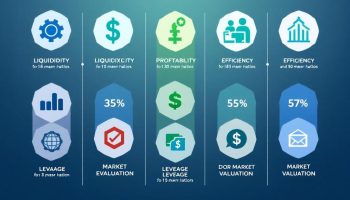
Understanding Finance Department KPIs
Finance Department KPIs function as essential strategic tools that offer complete insights into your organization’s financial health. They enable data-driven decision-making and accurate performance tracking. When you implement targeted KPI metrics, your finance department can convert historical financial data into forward-looking strategic instruments that boost organizational growth and operational efficiency.
Key Takeaways
- Financial KPIs act as an early warning system for potential financial issues and opportunities
- Well-designed metrics enhance accountability and align financial outcomes with broader business goals
- Comprehensive KPI tracking can improve organizational performance by 29% through data-driven insights
- Strategic KPI implementation requires quantifiable, reliable, and regularly updated metrics
- Finance department KPIs should connect daily activities to long-term financial objectives
Financial performance indicators help you monitor your business health in real-time. These metrics allow you to spot trends before they impact your bottom line. Your finance team needs clear, actionable KPIs to make sound financial decisions.
Regular analysis of these indicators provides your company with competitive advantages. Finance departments that actively track their performance metrics typically outperform those that don’t. Properly structured KPIs create a direct link between daily financial operations and your strategic goals.
Return on investment metrics belong at the core of any financial KPI framework. You’ll gain more control over financial outcomes when you establish measurable targets for each indicator.
The most effective finance departments update their KPIs quarterly to reflect changing market conditions. This adaptive approach allows your team to respond quickly to financial challenges and opportunities. Implementing financial dashboards can streamline this process, giving stakeholders easy access to critical performance data.
“Finance department KPIs are not just indicators; they are strategic navigators that transform historical data into actionable insights, steering organizations towards growth and efficiency. By aligning metrics with long-term objectives, these critical tools enhance accountability and illuminate pathways to financial success.”
Importance of Financial KPIs
Financial KPIs serve as your organization’s vital signs, providing critical metrics for assessing financial health and operational efficiency. These KPIs for the finance department create a framework that enables data-driven decision-making and effective strategic planning. You’ll find that well-chosen KPIs for the finance department measurements align financial outcomes with broader business goals, offering clear insights into organizational performance and future growth potential.
Your finance department functions as the central nervous system of your business, making KPI for finance department tracking essential for maintaining operational clarity. These indicators help you detect financial trends before they become problematic and identify opportunities for improvement. Finance teams using targeted KPI for finance department metrics typically make faster, more accurate decisions compared to those relying solely on periodic financial statements.
Key Benefits of Financial KPIs
Financial KPIs provide several strategic advantages when implemented correctly:
- Early warning system for financial issues
- Benchmarking against industry standards
- Enhanced accountability across departments
- Improved budget forecasting accuracy
- Better alignment between financial and strategic goals
The value of these metrics extends beyond the finance department. According to research, businesses that implement comprehensive KPI for finance department frameworks show 29% higher profitability than those without structured measurement systems. You can improve your strategic planning by incorporating these financial metrics into your decision-making process.
| Benefit | Impact on Organization |
|---|---|
| Data-Driven Decisions | Reduces subjective judgment in financial planning |
| Strategic Alignment | Connects daily activities to long-term financial goals |
| Performance Visibility | Provides clear metrics for measuring departmental success |
| Risk Management | Identifies financial vulnerabilities before they escalate |
| Resource Optimization | Guides better allocation of capital and human resources |
Your finance team should prioritize KPI for finance department metrics that reflect your specific business challenges and objectives. When selecting these indicators, focus on those that directly influence your strategic dashboard and provide actionable insights rather than simply measuring activity.
By implementing targeted KPI for finance department tracking, you’ll transform financial data from backward-looking records into forward-looking strategic tools. This approach creates a more proactive financial function that supports organizational growth and helps navigate financial challenges with greater confidence and precision.
Expert Insight: Prioritize Financial KPIs for Strategic Success**
Financial KPIs act as essential indicators of your organization’s fiscal health, enabling proactive decision-making and strategic alignment across departments. By selecting metrics that directly reflect your business challenges and goals, you transform historical data into actionable insights that enhance accountability and drive performance. Emphasizing targeted financial KPIs not only identifies potential risks early but also boosts overall profitability and operational efficiency.
Essential Profitability and Performance KPIs
Tracking the right KPI for finance department operations can transform your organization’s financial health and decision-making capabilities. Your finance team needs clear metrics to guide strategic planning and evaluate business performance effectively.
Operating Cash Flow (OCF) stands as a fundamental KPI for finance department monitoring, with 72% of businesses prioritizing it as their key financial indicator. This metric measures cash generated from core business operations, providing a clear picture of your liquidity and operational efficiency. A consistently positive OCF signals strong organizational health and the ability to fund growth without external financing.
Revenue Growth Rate helps you evaluate the effectiveness of your sales and marketing strategies while indicating business expansion potential. This KPI for finance department analysis tracks percentage increases in revenue over specific periods, allowing you to spot trends and make strategic planning adjustments as needed.
Profit margins offer critical insights into your financial efficiency. Consider these essential KPI for finance department tracking:
- Gross Profit Margin: Percentage of revenue remaining after deducting Cost of Goods Sold
- Net Profit Margin: Percentage of revenue remaining after all expenses
- Target: Increase net profit margin from 32% to 40%
Financial risk assessment requires specific KPI for finance department evaluation. Return on Investment (ROI) is used by 85% of businesses to assess financial performance, helping you measure investment efficiency and evaluate strategic financial decisions through a performance dashboard.
Liquidity and debt ratios provide vital insights into your financial stability. The Current Ratio measures your ability to pay short-term debts, while the Debt-to-Equity Ratio assesses financial leverage and risk exposure. These KPI for finance department monitoring help prevent cash flow problems before they occur.
Implementing Effective Financial KPIs
Your financial KPIs must possess certain characteristics to deliver maximum value. They should feature high resolution with specific targets, efficiency orientation, and quantifiable goals. Ensure your KPI for finance department tracking relies on reliable data sources with regular, timely reporting.
Comprehensive KPI tracking delivers multiple benefits including improved financial decision-making, enhanced organizational performance, better capacity planning, and proactive risk management. By selecting the right KPI for finance department oversight, you’ll gain actionable insights that drive sustainable growth and profitability.
Organizations that leverage data-driven insights to inform their key performance indicators see a 20% improvement in overall financial performance.
hbr.org
Financial Risk and Investment Metrics
Tracking the right KPI for finance department operations helps you identify risks and measure investment performance effectively. Your finance team needs clear metrics to evaluate financial stability and make strategic decisions that support business growth.
Return on Investment (ROI) stands as a critical KPI for finance department analysis, used by 85% of businesses to assess financial performance. This metric helps you determine whether your investments are generating adequate returns and guides resource allocation decisions. When implementing strategic planning, ROI calculations provide quantifiable evidence of investment efficiency, allowing you to prioritize initiatives with the highest potential returns.
Liquidity and debt ratios form another essential category of KPI for finance department monitoring. The Current Ratio measures your ability to cover short-term obligations with available assets, while the Debt-to-Equity Ratio evaluates financial leverage and potential risk exposure. These KPI for finance department tracking provide critical insights into your company’s financial stability and capital structure.
Key Risk Management Metrics to Monitor
Your finance department should track these essential KPI for finance department risk management:
- Cash Conversion Cycle: Measures the time required to convert investments in inventory and resources into cash flows
- Working Capital Ratio: Evaluates operational efficiency and short-term financial health
- Interest Coverage Ratio: Assesses your ability to meet interest payment obligations
- Accounts Receivable Turnover: Tracks efficiency in collecting outstanding payments
- Capital Expenditure to Revenue: Monitors investment levels relative to business growth
The following table summarizes critical investment metrics your finance department should monitor:
| KPI for Finance Department | Purpose | Target Range |
|---|---|---|
| Return on Equity (ROE) | Measures return on shareholder investment | 15-20% |
| Return on Assets (ROA) | Evaluates efficient use of assets | 5-10% |
| Economic Value Added (EVA) | Calculates value created beyond cost of capital | Positive and growing |
| Internal Rate of Return (IRR) | Assesses project profitability | Above hurdle rate |
Implementing these KPI for finance department tracking helps you maintain operational risk management standards while maximizing returns. Your finance team should regularly review these metrics against industry benchmarks to identify improvement opportunities and mitigate potential financial risks before they impact your business performance.

Strategic KPI Implementation and Best Practices
Implementing effective KPI for finance department metrics requires a systematic approach that balances analytical rigor with practical application. Your finance team needs clear, measurable indicators that drive performance while supporting broader business objectives.
Financial KPIs must possess specific characteristics to deliver maximum value. They should feature high resolution and specificity, focusing on particular aspects of financial performance rather than broad generalizations. Each KPI for finance department should be quantifiable with clear targets that align with your organizational goals.
When selecting appropriate KPI for finance department metrics, consider these essential attributes:
- Project-specific targeting that connects financial outcomes to specific initiatives
- Efficiency-oriented measurements that track resource utilization
- Quantifiable and goal-driven metrics with defined benchmarks
- Reliable data sources that ensure accuracy and consistency
- Regular, timely reporting to enable proactive decision-making
The right KPI for finance department framework transforms raw financial data into actionable insights. You’ll gain the ability to make strategic planning decisions based on concrete evidence rather than assumptions. This data-driven approach enhances organizational performance across multiple dimensions.
Benefits of Comprehensive KPI Tracking
Implementing a robust KPI for finance department system delivers several tangible benefits that impact your bottom line and operational effectiveness. These performance metrics serve as your financial compass, guiding decisions and resource allocation.
A well-designed set of KPI for finance department metrics enables:
- Improved financial decision-making through quantitative analysis
- Enhanced organizational performance by identifying improvement opportunities
- Better resource allocation based on return metrics
- Proactive risk management through early warning indicators
Your finance department’s KPIs should connect directly to broader business objectives. When properly implemented, these metrics create a feedback loop that continually reinforces strategic priorities and drives performance improvements.
Regular review of your KPI for finance department framework ensures these metrics evolve with your business needs. You’ll want to establish a quarterly assessment process to evaluate whether current KPIs still address your most pressing financial challenges and opportunities.

Transforming KPIs into Actionable Insights
Your finance department’s KPIs for finance department shouldn’t just be numbers on a dashboard. They need to drive real business decisions. Converting financial metrics into strategic actions requires systematic analysis and clear communication across your organization.
Comprehensive KPI tracking delivers tangible benefits beyond basic reporting. You’ll notice improved financial decision-making when your team can quickly identify trends from properly formatted financial KPIs. With proper implementation, your finance department’s KPIs will transform raw data into meaningful insights that directly impact your bottom line.
Benefits of Financial KPI Implementation
Implementing effective KPI for finance department tracking systems creates numerous advantages:
- Enhanced organizational performance – When finance teams track the right metrics, they can identify operational inefficiencies quickly and implement corrective measures.
- Better resource allocation – Financial KPIs highlight areas that require additional investment or where resources are being underutilized.
- Proactive risk management – Early warning indicators within your finance KPIs allow you to address potential issues before they become critical problems.
- Strategic alignment – Well-designed finance department KPIs connect daily operations to long-term business objectives.
The impact of proper financial KPIs extends beyond the finance department. You’ll find that 72% of businesses prioritize Operating Cash Flow as a key financial indicator because it provides insights that benefit multiple stakeholders. When you conduct strategic reviews using these metrics, you create opportunities for cross-functional collaboration.
Your KPI for finance department implementation should include regular analysis sessions where team members can interpret data and suggest action plans. This transforms static metrics into dynamic tools for growth. Effective financial KPIs require both technical accuracy and practical application – they must be both measurable and meaningful.
The most successful finance departments develop clear processes for turning KPI insights into concrete steps. This might include establishing thresholds that trigger specific actions, creating standardized response plans for negative trends, or developing incentive structures tied to KPI achievement. When you use dashboards to drive performance, you empower your entire organization to make data-informed decisions.
Remember that your KPI for finance department approach should evolve as your business grows. What worked during startup phases may become less relevant as you scale. Regular reassessment ensures your financial metrics continue providing meaningful guidance for your strategic decisions.






